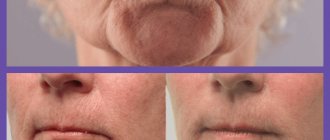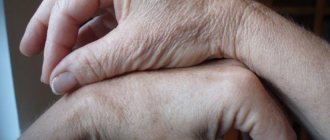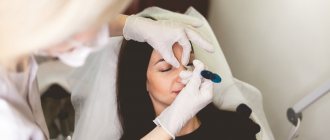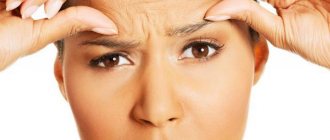A trip to a cosmetologist for lip augmentation naturally begins with the question: what size is trending? But it is important to take into account not only fashion trends. The initial data largely determines the final result of the procedure. How do you know if your lips are naturally harmonious? How to understand how much they can be increased so as not to get the anecdotal “duck” effect? How to compare the size of the mouth with the rest of the facial features? And most importantly, how to find out whether you need contouring at all?
In this article we will touch on the controversial issue of the most ideal lip shape.
Statistics, golden ratio and science.
In cosmetology and plastic surgery, scientific and statistical parameters of the lips are accepted, which characterize the “ideal” shape - ratios, symmetry and numerical expressions of volume. However, you and I understand that some people like “plumpier”, some “elastic”, some with relief, and some with a clear contour. You can find a friend based on taste and color, but not right away.
Professional cosmetologists with experience try not to pay attention to numbers and ratios, because the attractiveness of the lips is assessed exclusively in the complex of the entire face, and the most important thing about them is naturalness. But when it is possible to bring the patient’s lips closer to ideal proportions, when the patient’s wishes and the possibilities of correction coincide, then there is no shame in the result of the correction.
Golden ratio principle
Approximate and average norms for the structure of the nasolabial triangle:
- The proportion of the upper and lower lips is approximately 1:1.6 (size and width)
- The volume (bulge) of the upper lip at the extreme point is literally 1-2 mm greater than the same parameter of the lower lip
- The size and width of the upper lip is, on the contrary, 10-25% smaller than the lower lip
- The distance from the lower part of the nose (septum) to the lower part of the philtrum (base of the upper lip in the middle) is 1.7-2.3 cm
- The distance from the middle part of the contour of the lower lip to the contour of the chin is 3-4 cm
- The width of the philtrum corresponds to the width of the two front teeth
- Open smile: 2/3 exposure of the anterior incisors and complete or almost complete concealment of the lower incisors
By the way, a group of scientists from the American Society of Plastic Surgeons conducted an experiment with a survey of 6,000 people. They were shown an image of a girl whose lips were changed in a graphic editor - from very thin to very lush. Those surveyed unanimously chose the option of an increase of 50% from the original.
People also voiced the opinion that ideal lips make up approximately 10% of the area of the lower third of the face. Now they plan to include these criteria in the advisory instructions for aesthetic surgeons and cosmetologists.
The tasks of harmonizing proportions can be diametrically opposed. And objectively, “small” lips do not always need additional volume - perhaps the defect is associated with the distance between the nose and the edge of the red border.
Ricketts line, S-line, line from nose to chin
Another test for determining the harmony of mouth proportions is called the “aesthetic Ricketts E-line.” It is conventionally drawn in profile from the tip of the nose to the most convex part of the chin, like the blue line in our illustrations.
You can often find a line that connects the extreme point of the chin, passes along the extreme points of the lips and rests on the nose.
You can estimate the required lip proportions using these diagrams yourself; it is believed that lips extending beyond the green line (or touching the blue line) look unnatural and are too dominant. The recommended profile is shown in Figure 2.
Only a cosmetologist with experience and a harmonious look can understand these minor features of symmetry. Look at the same profiles, but without the line tips.
The peculiarity of lip size corrections in profile is that the “ideal” depends not only on the size of the lips, but also on the size of the chin and nose!
See how the protruding, hyper-corrected lips from Fig. 3 can be brought back to normal by enlarging the chin with fillers (hover your mouse over Fig. 3).
Reading lips
Vladimir Maleshin
Is it possible to describe a person’s character down to the smallest detail just by looking at his… lips? Some consider this complete nonsense, others are skeptical and wary of the technology, others agree - yes, physiognomy has a right to exist - but never use it in their personal lives and professional activities. Vladimir Maleshin, one of the most respected HR people in Russia, trusts physiognomy one hundred percent. He really knows how to read people's faces and lips. How he does it? We tried to find out in an exclusive interview.
How do you convince your managers that a candidate is not suitable for the job based on physiognomy parameters, despite an ideal resume?
- The fact is that over the years, experience began to work for me - like a test book for a student. With age it has become much easier, I don’t have to spend a lot of time on persuasion, people rely on my professionalism. In general, of course, I use many comprehensive assessment methods. Physiognomy - I would like to especially emphasize this - is only one of the components of an integrated approach to assessing a candidate. You need to be able to ask tricky questions, apply elements of a stressful interview, find out during the interview about a person’s shortcomings, and tell the manager what potential threats this candidate may pose.
One of our magazine’s best friends, Boris Khigir, is a frantic preacher of the theory that a person’s character corresponds to his name and patronymic. How do you feel about this technique? Is it stronger or weaker than physiognomy?
— Based on practice and my life experience, I confirm: the theory of determining a person’s qualities by name and patronymic is absolutely correct. I am deeply convinced that a person's character is formed to a large extent by the name that a person is called from the first day of birth. Moreover, note that this name is pronounced by different people - parents, friends, acquaintances - and in accordance with the timbre of the child’s voice, different parts of the brain will be activated. A person begins to perceive the world through his name, and thus his character is formed. Moreover, I would say that the formation occurs depending on how often and strongly certain areas of the brain are activated from the first hours of the baby’s birth.
You speak respectfully of this theory. Do you use it yourself?
- No. I am deeply convinced that a professional should rely on those methods that he himself knows perfectly. I have been studying physiognomy since 1968. 42 years have already passed since I, as a first-year student, read Veresaev’s book. It contained the following words: “The eyes are the mirror of the soul. What nonsense!.. What nonsense! Eyes are a deceptive mask, eyes are screens that hide the soul.
The mirror of the soul is the lips. And if you want to know a person’s soul, look at his lips. Watch out for your eyes! Because of the eyes, this is how people are often mistaken. Your lips won't deceive you." From that moment on, I began to observe people's lips and relate them to their characters. I felt the first joy of being able to determine character from lips after just a few months of observing people. Now, 40 years later, I have a certain “video library” of lips in my head, behind which there are certain personality traits, behavioral characteristics, etc. Lips, in my opinion, are the most accurate, most faithful and most powerful tool for assessing a stranger .
Lips, like other external signs, are genetics, a “gift” from parents. What happens, we are initially born with a “ready-made” character and are unable to change it?
- Undoubtedly, character is given to us along with genes. A person's behavioral characteristics may change over time, but personality traits do not change. You know, a dispute often arises as to whether the child will have a “mother’s” or “father’s” character. So here's some simple advice, it's very easy to determine: just look at whose lips it is. The conclusion seemed obvious... but it had to be reached in a practical way.
This has been repeatedly tested by me, confirmed by my parents, demonstrated in photographs, told at my seminars, etc. Psychologists often say that character is formed during adolescence.
— Once again I emphasize: we receive character at birth along with genes. During adolescence, certain emotional and psychophysiological changes occur: a person becomes more stubborn, nervous, receptive, and so on, but innate character traits are preserved. Other behavioral traits are determined not only by intelligence, but also by dependence on life situations. The instinct of self-preservation forces us to put on a mask that is beneficial at the current moment. Therefore, every person, finding himself in an unfamiliar situation and communicating with unfamiliar people, will always hide his shortcomings, trying to show himself better than he really is. But he cannot change the shape of his mouth.
“He can’t, and no matter how hard he tries to show at the first meeting how kind, affectionate and fluffy he is, you can already tell from the downturned corners of his lips alone: this is a demanding, cruel, grumpy person.”
Perhaps this is exactly what is needed, say, for the position of security chief?
- This is a very interesting moment. You can really tell by the lips whether a person is suitable for working in the security service or not. Obviously, he must have an innate ability to keep a secret and not share it with anyone, under any circumstances. Only those people who have a small mouth are capable of this (when the width of the mouth is significantly less than the imaginary vertical lines that can be drawn through the middle of the pupils). When a person has lips of at least average width, situations will certainly arise in his life when it will be difficult for him to retain information of a secret nature: “I’ll just tell you, but under no circumstances tell anyone else.” A wide mouth indicates extroversion, the ability to communicate easily, and enjoyment of communication; but, as you already guessed, such people cannot be trusted with secrets.
There are now a lot of books on physiognomy on the shelves of bookstores, aimed at a mass audience. But HR people and managers really still don’t want to take this technology into account.
- This is actually true. At one of the seminars several years ago, we conducted a study on how much HR trusts physiognomy when assessing a candidate. The result is as follows: the average score among men is 3.6, among women - 5.8. This indicates an underestimation of the significance of the technique, lack of sufficient popularization, and most importantly, lack of knowledge in this area. Personally, I give physiognomy ten points out of ten. Physiognomy is the most effective tool for assessing a stranger!
The problem is not even that HR people don’t believe in the effectiveness of the methodology - it’s just that the choice of candidates is often too narrow. Right now you have four resumes on your desk. If all these candidates have the “wrong” mouth, will you continue to look further?
- Unfortunately no. Often you have to choose from a limited number of candidates who are suitable solely on professional qualities. Candidates may not be suitable in terms of salary level, compliance with corporate culture, mentality, etc. You have to restrain your joy from communicating with a person who has a pleasant character, who is easy-going, flexible and communicative, not capricious, non-conflict, but lacks professional competencies, and give preference to a tough, intolerant, unrestrained professional.
Why, then, is your technology needed at all? Why Higira technology?
— They work when the labor market allows you to choose 30 candidates out of 20. Then you can look at both professional qualities and physiognomy. Now, thank God, there is a choice. Of course, it is different for different specialties, but it is especially difficult for students now - on average there are more than 20 people per place. Now there is a large selection of candidates in pharmaceuticals, sales, and medicine. The situation has generally improved recently. The first significant warming occurred in the fall of 2009. New vacancies have appeared, which have allowed the labor market to become more active.
Of course, it is difficult to fit your forty years of experience with the technique into our interview and reduce it to some specific things. But let’s still try to formulate some simple tips on how to “read” a person’s lips. You have already mentioned the dependence of the ability to keep secrets on the size of his mouth. What other conclusions can be drawn “at first glance”?
— I will be happy to share with readers those conclusions that I have tested many times and work in one hundred percent of cases. Let's start with the “crooked” mouth. When a person talking to you curves his lips, lowering one side asymmetrically, this speaks of depravity - first of all, arrogance, disregard for other people. In principle, a crooked mouth is a sign of a complex character, be careful with such people!
One of the most striking signs: the dependence of a person’s character on the fullness of his lips. Let's take two extreme situations - very thin lips and full, “heart-shaped” lips. People with thin lips live by reason, relying on the mind, while people with full lips are sensual, emotional, more often listening to their hearts. Depending on the fullness of the lips, a person in life will more often rely on either the mind or the heart. Thin lips indicate good friends, and large, full lips indicate sybarites. Look at your profile. People of good character will have the same fullness in their upper and lower lips. (But keep in mind that in men, the lower lip is often fuller than the upper, and this is the norm). Obvious flaws in character will be indicated by a protruding lower lip or a curled upper lip. There may be a lot of explanations and details here, but I will say the simplest things: a protruding lower lip speaks of a person’s swagger, and a curled upper lip indicates indecisiveness.
When the upper lip is fuller than the lower, it is better not to argue with such a person - it is almost impossible to convince him. Raised upward corners of the mouth indicate optimism, dimples in the corners of the lips and on the cheeks are a sign of good character. Egocentrics and skeptics live with corners down. If we talk about the line of closing the lips, for people with a calm character it is smooth, horizontal, but for overly emotional people it is wavy; To be convinced of this, just look at the line where Vladimir Zhirinovsky’s lips close. Also, when meeting a person, it is useful to pay attention to the contours of the lips, the so-called Cupid's line. For simple, simple-minded people, it is smooth and calm. Those who have a clear and bright Cupid line have a sophisticated mind, they are able to generate ideas, make suggestions, and be witty. At the same time, these people can be very sarcastic, harsh and sharp.
Among people with beautifully defined lips there are many extraordinary personalities, but among them there are also those who can take sophisticated revenge, hit painfully, and find a reason to subtly humiliate another person. I have conducted over 40,000 interviews in my life. All of the above observations are based on my extensive practice of interviewing and assessing strangers. My home library of books on physiognomy, the language of facial expressions and gestures is about the size of my height. All these books have been read and analyzed, but I use only what has been proven in practice in my work.
Let's summarize: which people at work should you behave very carefully with?
“As I said, a person with a full upper lip is not someone you should engage in any kind of confrontation with.” You can’t tease him, it’s better not to argue with him, this could end in a serious conflict. A boss with a protruding lower lip is capricious and arrogant; when communicating with him, you need to be flexible and careful, once again “not teasing the beast.” By the way, it is not the protruding lip that speaks especially strongly about stubbornness, but protruding ears, and the stronger it is, the more pronounced it is. If your child has such ears, you can immediately tell that raising him will be very difficult.
Who can take revenge?
— People with thin lips or a “sophisticated” Cupid line.
What about betraying?
“This is a very subjective, personal concept that goes beyond behavioral characteristics. Everyone has their own definition of betrayal. A person with any lip shape can betray... it is simply impossible to predict.
Bite correction, plastic surgery, stroke - all this greatly changes a person’s face. Can a change in appearance lead to a change in character? And does physiognomy work in such cases?
— The physiognomist’s first enemy is plastic surgery. If a woman has changed her lips through plastic surgery, a mistake is inevitable. I think that the behavioral signs of a person who has undergone plastic surgery change in any case; however, I do not dare to judge how much the character itself changes, because I do not have such statistics. And a change in face as a result of a stroke is a rare case, far from the topic of our conversation. I would like to draw your attention to this: with age, a person’s lips seem thinner, although in fact they simply become more closed because the teeth are gradually eaten away. This is a natural aging process that should always be taken into account when assessing an older person.
What other “corrections” need to be made when assessing a person’s face?
— There are gender differences in the structure of faces. For example, women typically have the same fullness in their upper and lower lips, and 60% of men have a larger lower lip than their upper lip. This is the norm and does not indicate character traits. Adjustments also need to be made for race: representatives of the Mongoloid, Caucasian and Negroid races have different skull structures, different shapes of lips, nose, and so on. This does not mean that physiognomy does not work there. It works effectively - but within the framework of one race or another. All my arguments today relate to the European, primarily Slavic, type of face.
Everything we talked about now related to a static face. What conclusions can be drawn from the dynamics - lip movements, smiles, conversation, etc.?
— There is one interesting detail that I noticed when communicating with people (this is solely my observation, you will not find this in any book): if during a conversation a person’s upper row of teeth is exposed, he has an easy character. Accordingly, when the lower teeth are exposed, this means that in front of you is a complex, “biting” person. It is logical that a low-emotional person’s lips and facial expressions remain relatively calm during a conversation. In turn, in people who are overly emotional, the Cupid line is constantly moving, literally “shaking.” However, there are also “static” marks on the face, these are dimples. In the corners of the lips and on the cheeks they speak of a good, easy character, and on the chin - the opposite.
A lot can be said by facial wrinkles. Crow's feet form in the corners of the eyes of people with a light character, those who often smile and laugh. Many women ruthlessly destroy these charming wrinkles with the help of Botox. Unfortunately, along with them, those “signals” that indicate the smiling and friendly nature of these women also go away. The emotionality of a person in adulthood is easy to determine based on the folds and wrinkles on the face. Especially the pronounced nasolabial fold, wrinkles on the forehead... You know, I really like the joke my mother told me as a child: Why do women have vertical wrinkles on their foreheads, while men have horizontal ones? Because a woman constantly asks: “Where is the money?”, and a man raises his eyebrows in surprise: “What money?”
When talking about the stubbornness of bosses, you mentioned not only lips, but also ears...
— Ears are a part of the face that, in terms of physiognomic significance, I put in second place after lips. By the way, by the ears you can determine not only the character, but also the resource of health and longevity. Large ears with well-formed earlobes are a 100% guarantee of longevity. A strong, fleshy lobe is a sign of energy, health, and emotional development of a person. But the most important thing is, of course, the size of the ears. Look today at the veterans of the Great Patriotic War, at other centenarians - everyone, without exception, has huge ears. Good physical condition is also indicated by strong, even teeth, healthy skin and hair, a clean forehead and whites of the eyes, and long eyebrows. Short eyebrows - especially if it is noticeable that the ends are falling out - are an indicator of diseases of the endocrine system.
At seminars, I not only talk about this, but also show dozens of examples in photos in order to teach clearly and visually.
One of your greatest successes...
— Formation of the team in the 90s. When I arrived there, forty people were working there; I brought the number of the company to four hundred. At the same time, the production and sales of computers, the investment department, Sunrise Bank, etc. were organized - all departments worked as one cohesive team. Unfortunately, the company existed for only a few years, but during this time there was zero staff turnover. My merit in this regard was the competent selection of personnel. There were no conflicts in the team at all.
All thanks to physiognomy?
- And her too. Thanks to a large selection competition, I had the opportunity to rely on all my professional knowledge, including physiognomy. I repeat: all assessment and selection methods must be used in combination.
How to learn physiognomy?
— Anyone who wants to comprehend this complex, but amazing and magical way of assessing people can learn physiognomy. The secret to mastering physiognomy is simple: you need to start observing and assessing the character of a person’s face and lips, starting with the people closest to you and well known to you. Gradually, you will learn to match certain character traits with a person's facial features. But this will take years...
And for those who want to learn this art in one day, there is an opportunity to meet at my seminar, which will be organized by the magazine.
The ratio of lip volume to other facial parameters
In addition to a sober assessment of the initial structure of the lips, it is important to take into account the overall proportions of the face.
Rhinoplasty surgeons know that the problem of a large nose is not always associated with the true massiveness of its tissues. A prominent nose may be a consequence of chin hypotrophy and distal occlusion.
A similar story with the mouth. The same medium-sized lips will look completely different on a petite heart-shaped face and a full square face. Other parts of the face also play a major role in perception - eyes, nose, cheekbones.
People with the following initial data can safely enlarge their lips:
- Oval shaped face with regular features
- Smooth contour of the lower jaw, narrowed downwards
- High cheekbones
- Large distance between the philtrum and the tip of the nose
- Thinness of lips in comparison with other facial features
- Normal bite
People with the following data should approach lip augmentation with caution
- Elongated and angular face shape - with the slightest overcorrection there is a risk of getting the rough appearance of a “travesty”
- Large and bulging eyes - with hypercorrection there is a possibility of becoming like the heroine of a Soviet cartoon about the blue sea
- Open bite - with overcorrection, the lower part of the face will protrude more forward, which will create something of a “Neanderthal” effect
- A small face with subtle “doll-like” features - with hyper-correction you will get a caricature, or even “alien” appearance
This does not mean that you should forget about lip shape correction for the listed features. But this means that you should choose a doctor with a developed aesthetic sense and taste, who is interested in the beautiful result of the procedure, and not in selling a large dosage of filler.
Also, do not insist on a specific volume: the cosmetologist can better see what your lips and face as a whole . It is more profitable to come back for correction and add fullness after distribution and “shrinkage” of the drug than to inject hyaluronidase to completely or partially break down the gel.
Hypercorrection?
Cosmetologists often have to be torn between the medical rule “do no harm” and the corporate rule “the client is always right.”
And yet, an honest doctor would rather choose the option of parting with one client than tarnish his reputation. “Duck” lips are the object of mass ridicule and jokes. Online celebrities, who 5-6 years ago promoted their huge lips as an “image feature,” got rid of them surgically. “Experienced” patients in terms of contour plastic surgery are showing more and more caution with the previous requests to “inject the maximum volume.” And cosmetologists who allow hyper-correction create anti-advertising for themselves.
We don't like lips that are enlarged like this:
The mechanism of formation of marionette wrinkles
The root cause of the appearance of this cosmetic defect is the structural feature of the epidermis and the orbicularis oris muscle, which is responsible for the movements of the lips. This muscle, unlike other muscle groups, experiences enormous stress: it contracts during conversation, eating, and expressing emotions. Since the teres muscle bundles are attached directly to the dermis, the skin changes its shape along with it. Of course, this cannot but affect her condition. Gravitational ptosis also makes its contribution to the process of formation of “puppets”. Over time, the natural framework of the skin, created from collagen and elastin, weakens, and the amount of these protein compounds reproduced by epidermal cells is significantly reduced. All this together leads to a decrease in skin turgor. As a result, the corners of the mouth lower under the influence of gravity, and the folds leading to the chin become deeper, and therefore more noticeable.
There are other factors that provoke the appearance of labiomental wrinkles. Among them:
- excessive insolation leading to photoaging of the skin
- sudden weight loss or gain (both cause stretching of the skin)
- age-related hormonal changes that affect the amount of hyaluronic acid, collagen and elastin produced by the skin
- improper skin care
- features of the anatomical structure of the facial bones, malocclusion
- abuse of decorative cosmetics
- presence of bad habits
It should be noted that with age, marionette wrinkles appear in almost everyone, regardless of the type of aging. People who are aging according to the deformation, muscular and fatigue types are most susceptible to their formation. The least likely to be bothered by marionette wrinkles are those whose type of aging can be classified as finely wrinkled.











